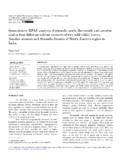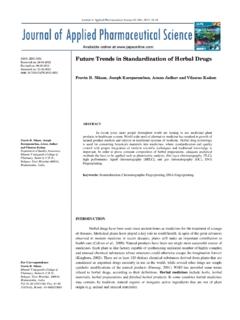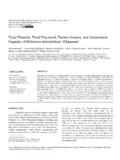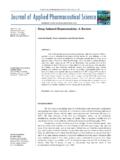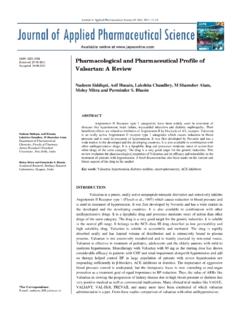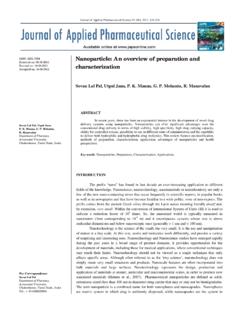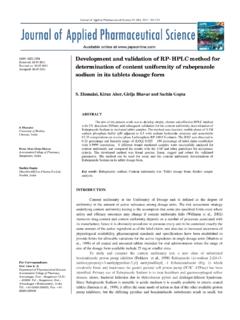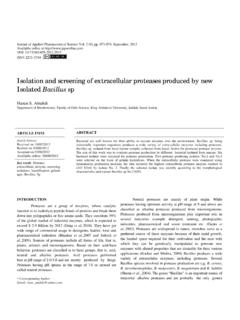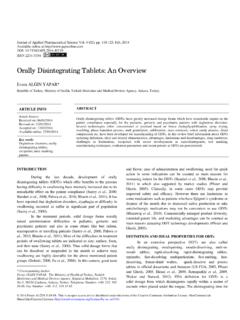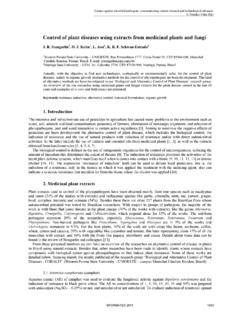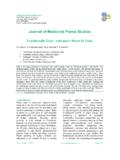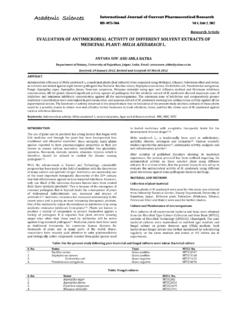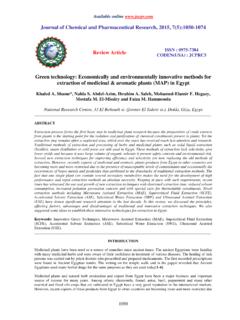Transcription of In-vivo and in-vitro screening of medicinal plants …
1 Journal of Applied Pharmaceutical Science 02 (06); 2012: 19-33. ISSN: 2231-3354. Received on: 01-06-2012. In-vivo and in-vitro screening of medicinal plants Revised on: 15:06:2012. Accepted on: 10-06-2012. for their anti-inflammatory activity: an overview DOI: Mohini A. Phanse, Manohar J. Patil, Konde Abbulu. Pravin D. Chaudhari and Bhoomi Patel Kaiser Hamid, Farhana Diba, Md. Razibul Habib ABSTRACT. Department of Pharmacy, East West University, Despite the progress made in medical research for the past decades, the treatment of Dhaka, Bangladesh. many serious diseases is still problematic. Inflammation is the response of living tissues to injury. It involves a complex array of enzyme activation, mediator release, extravasations of fluid, cell migration, tissue breakdown and repair. Inflammation has become the focus of global Kaniz Fatima Urmi, Fatema Tuz scientific research because of its implication in virtually all human and animal diseases.
2 As a Zohera result of adverse effects such as gastric lesions caused by non-steroidal anti-inflammatory drugs Department of Pharmacy, Jahangirnagar University, (NSAID), tolerance and dependence induced by opiates, the use of these drugs as anti- Savar, Dhaka, Bangladesh. inflammatory agents have not been successful in all cases. Therefore, new anti-inflammatory drugs lacking these side effects are being researched as alternatives to NSAID and opiates. Attention is being focused on the investigation of the efficacy of plant-based drugs used in the Muhammad Erfan Uddin traditional medicine because they are cheap, have little side effects. Hence, in the present review Department of Pharmacy, the various animal models used for preclinical screening anti-inflammatory activity herbs was International Islamic University compiled. Chittagong, Bangladesh. Keywords: Inflammation, Animal Models, Plant Extract, Mechanism of action.
3 INTRODUCTION. Inflammation is part of the complex biological response of vascular tissues to harmful stimuli, such as pathogens, damaged cells, or irritants. Inflammation is a protective attempt by the organism to remove the injurious stimuli and to initiate the healing process. Inflammation is not a synonym for infection, even in cases where inflammation is caused by infection. Although infection is caused by a microorganism, inflammation is one of the responses of the organism to For Correspondence Md. Razibul Habib the pathogen. Without inflammation, wounds and infections would never heal. Similarly, Lecturer progressive destruction of the tissue would compromise the survival of the organism (Wikipedia). Department of Pharmacy The plants are one of the most important sources of medicines. India is known due to availability East West University Dhaka, Bangladesh.
4 Of several thousands of medicinal plants in the different bioclimatic zones anti-inflammatory Cell: +8801718423453 diseases (Hemamalini et al., 2010). Journal of Applied Pharmaceutical Science 02 (06); 2012: 19-33. DIFFERENT MODELS USED TO STUDY the left hind paw of each rat. The extracts CFA (C. fistula INFLAMMATION Aqueous), CFM ( Methanolic) were administered orally 30 min prior to Carrageenan administration. The paw volume was Acetic acid induced vascular permeability (Lee et al., 2009). measured at 60, 120, 180, 240, minutes by the mercury Plant used: Asparagus cochinchinensis. displacement method using a plethysmograph. The percentage Family: Liliaceae. inhibition of paw volume in drug treated group was compared with Part used: Dried and pulverized roots. the control group. Diclofenac sodium was used as reference Common name: Aspargus root, shiny asparagus.
5 Standard. Solvent: 70% ethanol. Yield: Not mentioned. Mechanism of action Dose: 2 g/kg. The activity of C. fistula Linn. with aqueous and Route of administration: Orally methanolic extracts may be due to inhibition of the mediators of Chemical used: Indomethacin, Evans blue dye, Acetic inflammation such as histamine, serotonin and prostaglandin. acid. Conclusion Procedure plants which belong to Caesalpinaceae family are rich in Acetic acid-induced vascular permeability in ICR mice flavonoids and bio flavonoids are known for their anti- was performed as described previously. Briefly, 1 h after oral inflammatory and antioxidant activities. Further research is in administration of ACE (200mg/kg), indomethacin (5 mg/kg), or an progress to identify the biomolecules responsible for the anti- equivalent volume of vehicle (3%, v/v Tween 80), ml of Evans inflammatory and antioxidant activities.
6 Blue dye ( in normal saline) was administered intravenously through the tail vein. Thirty minutes later, the animals received 1 Carrageenan induced air pouch model ( Paschapur et al., 2009.). ml/100 g of acetic acid ( , v/v) Treated animals were Plant used:- Borassus flabellifer Linn. sacrificed 30min after acetic acid injection and the peritoneal Family:- Arecaceae. cavity washed with normal saline (3 ml) into heparinized tubes and Part used:-Male flowers. centrifuged. The dye content of the supernatant was measured at Common name:- Palmyra palm, toddy or wine palm. 610 nm using a microplate reader (molecular device). The results Solvent:- Ethanol. were expressed as arbitrary units of relative value. Yield:- Not mentioned. Dose:- 150 and 300mg/kg. Mechanism of action Route of administration:- Orally. The anti-inflammatory activity of A. cochinchinensis with Chemical used:- Pure Diclofenac Sodium.
7 70% ethanol extract may be due to blockade of pro-inflammatory cytokine production, neutrophil-mediated myeloperoxidase Procedure activity, inhibition of IL-1 and TNF- and to the subsequent The rats were divided into four groups. Rats were blockade of leukocyte accumulation anesthetized and air cavities were produced by subcutaneous injection of 20 ml of sterile air into the intrascapular area of the Conclusion back. An additional 10 ml of air was injected into the cavity every These results demonstrate that ACE is an effective anti- 3rd day to keep the space open. On the 7th day, 2 ml of 1% solution inflammatory agent in murine phorbol ester-induced dermatitis, of carrageenan dissolved in saline was injected directly into the and suggest that the compound may have therapeutic potential in a pouch to induced an inflammatory response. The rats were orally variety of immune-related cutaneous diseases.
8 Pre-treated with either vehicle or extract or diclofenac sodium 3 h prior to the injection of carrageenan. The second dose of treatment Carrageenan induced oedema.( Ilavarasan et al., 2005). was repeated after 24 h of the first treatment. 48 h after Plant used:- Cassia fistula Linn. carrageenan injection, the rats were anesthetized with ether and the Family:- Caesalpinaceae. pouch was carefully opened by a small incision. The volume of Part used:- Bark. exudates was collected and measured. An aliquot of the exudate Common name:- Amalltas. was used for quantification of leukocyte concentration using a Solvent:- Water and methanol. haemocytometer and differential cell count was performed using a Yield:- Water- 7% w/w and methanol- 9% w/w. manual cell counter after staining with Wright's stain. The results Dose:- 2000 mg/kg. were expressed as the total number of neutrophi's and monocytes.
9 Route of administration:- Orally. Chemical used:- Diclofenac sodium. Mechanism of action The anti inflammatory activity of B. flabellifer Linn. may Procedure be due to inhibiting either release of lysosomal enzymes or by Paw oedema was induced by injecting of 1% stabilizing the lysosomal membrane, which is one of the major Carrageenan in physiological saline into the subplantar tissues of events responsible for the inflamatory process. Journal of Applied Pharmaceutical Science 02 (06); 2012: 19-33. Conclusion Procedure plants which belong to Caesalpinaceae family are rich in Male rats weighing between 100-150 g were used. Paw flavonoids and bio flavonoids are known for their anti- edema was induced by an intradermal injection of carrageenin (1%. inflammatory and antioxidant activities. Further research is in in normal saline solution) or arachidonic acid ( in M.)
10 Progress to identify the biomolecules responsible for the anti- carbonate buffer, pH ) into the plantar surface of the right inflammatory and antioxidant activities. hind paw of the rats, at a volume of or ml, respectively. The edema volume was determined using a plethysmometer prior Carrageenan-induced pleurisy in rats (Badilla et al., 2003.). to and 1, 3 and 5 h after carrageenin injection, or 1 h after Plant used: Loasa speciosa. arachidonic acid injection. Test drugs were given 1 h prior to Family: Loasaceae. carrageenin or 2 h prior to arachidonic acid injection. Part used: Leaves. Common name: Campana. Mechanism of action Solvent: Water. The fruit juice extract of L. siceraria has a good predictive Yield: Not mentioned. value to screen anti-inflammatory agents. Inflammatory mediators Dose: 250 500 mg/kg. such as kinin, serotonin, and PGs are released by EPP.
